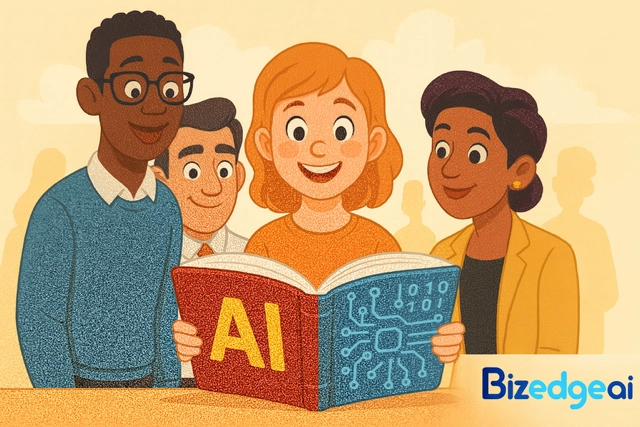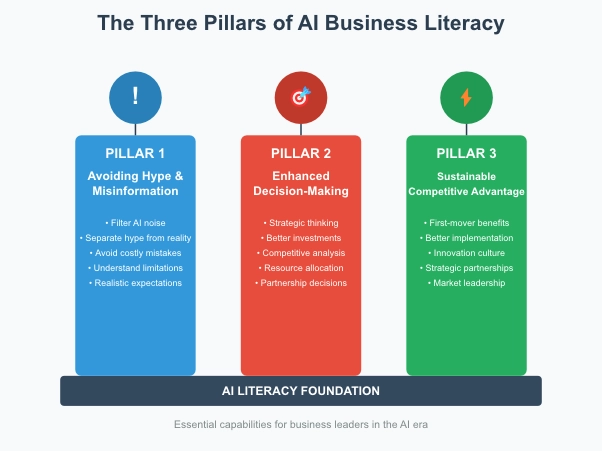Our Blog - Sharing & Informing

AI Literacy: The New Business Essential
Why Every Leader Needs to Understand Artificial Intelligence
Artificial Intelligence literacy has emerged as a critical competency for business leaders navigating today's digital landscape. While most executives may never need to code AI models, they must grasp the strategic implications, capabilities, and limitations of AI technologies (Brynjolfsson & McAfee, 2017).
Companies that embrace AI literacy at the leadership level are positioning themselves for unprecedented competitive advantages, while those that treat AI as merely an IT concern risk being left behind by more informed competitors.
Understanding Without Coding
The misconception that AI literacy requires technical programming skills has created a dangerous knowledge gap in many organisations. Business leaders often delegate AI decisions entirely to their technical teams, missing the crucial strategic perspective that only executives can provide.
Consider financial literacy. CEOs do not need to be certified accountants to read balance sheets or make informed investment decisions. Similarly, AI literacy does not require coding expertise; it requires understanding business applications, recognising opportunities, and appreciating limitations (Wilson & Daugherty, 2018).
What AI literacy encompasses for business leaders:
- Strategic Understanding: Knowing which business problems AI can solve and which it cannot
- Risk Assessment: Comprehending potential pitfalls, including bias, privacy concerns, and data quality issues
- Resource Allocation: Understanding actual costs and timelines for AI projects
- Performance Metrics: Knowing how to measure AI success and when to pivot

Figure 1 – The Three Pillars of AI Business Literacy
The Three Pillars of AI Business Literacy
-
Avoiding Hype and Misinformation
The AI landscape is riddled with exaggerated claims and fundamental misunderstandings about what current technology can accomplish (Marcus, 2018). AI literacy serves as a filter against this noise, enabling leaders to distinguish between substance and speculation.
Companies have wasted millions on AI projects doomed from the start because leadership believed vendor promises without understanding the underlying limitations. Common myths include the belief that AI will solve all problems, that more data always means better AI, or that AI will entirely replace human workers.
-
Enhanced Decision-Making Through Understanding
AI literacy transforms decision-making by providing leaders with a clearer understanding of where and how AI can create value. This knowledge enables more strategic thinking about technology investments and competitive positioning.
Strategic areas where AI literacy improves decisions include market opportunity assessment, competitive analysis, partnership evaluation, and investment prioritisation. Leaders who understand AI capabilities can identify new revenue streams, accurately assess competitive threats, and allocate resources more effectively.
-
Sustainable Competitive Advantage
AI literacy creates sustainable competitive advantages by enabling leaders to spot opportunities before competitors and implement AI solutions more effectively. This includes achieving first-mover benefits, implementing better strategies, fostering innovative cultures, and forming strategic partnerships (Porter & Heppelmann, 2014).
Industry Applications for Local Businesses
Manufacturing: Transforming Production
Manufacturing leaders who understand AI can implement solutions that reduce waste, improve quality, and increase efficiency. Critical applications include:
Predictive Maintenance: AI algorithms analyse equipment data to predict failures before they occur, reducing unplanned downtime by up to 50% (Lee et al., 2015).
Quality Control: Computer vision systems inspect products more efficiently than human workers, identifying defects with greater consistency while minimising waste.
Supply Chain Optimisation: AI analyses supplier performance and demand patterns to optimise inventory levels and minimise stockouts.
Facilities Management: Optimising Operations
Facilities management represents significant opportunities for businesses to implement AI solutions that deliver immediate returns:
Energy Management: AI systems analyse building occupancy and weather forecasts to optimise heating, cooling, and lighting, reducing energy costs by 20-30% (Molina-Solana et al., 2017).
Space Utilisation: Smart sensors track how spaces are used, enabling data-driven decisions about layouts and real estate optimisation.
Maintenance Scheduling: AI processes data from building systems to predict when infrastructure requires attention, preventing costly emergency repairs.
Building AI Literacy: Practical Steps
Developing AI literacy requires an ongoing commitment to understanding how AI technologies evolve. Successful approaches include:
Executive Education: Many business schools offer AI literacy programs designed for non-technical executives, focusing on strategic applications rather than technical implementation.
Pilot Projects: Starting with small, low-risk AI pilots allows leaders to gain hands-on experience while minimising potential downsides.
Industry Engagement: Attending AI-focused conferences and workshops provides exposure to real-world applications and case studies relevant to specific industries.
Cross-Functional Collaboration: Working closely with technical teams enables leaders to understand AI capabilities within the context of specific business challenges.
The Boardroom Imperative
The most successful organisations treat AI as a boardroom issue, not just an IT concern. This means that senior executives take personal responsibility for understanding the implications of AI for their business and industry.
Key elements include governance and oversight, incorporating AI into strategic planning, understanding human capital requirements, and staying informed about regulatory and ethical considerations (Ransbotham et al., 2017).
Conclusion
AI literacy has evolved from a nice-to-have skill to a business imperative. Leaders who understand AI capabilities and limitations are better positioned to make strategic decisions, avoid costly mistakes, and identify opportunities that less-informed competitors miss.
The manufacturer that prevents equipment failures through predictive analytics and the facilities manager that reduces energy costs through intelligent building systems share a common thread: leadership that understands how to harness AI strategically.
As AI becomes increasingly central to business operations, the divide between AI-literate and AI-illiterate organisations will only widen. The question is not whether your organisation will eventually need to embrace AI; it is whether your leadership team will be prepared to guide that transformation effectively.
The investment in AI literacy pays dividends in better technology decisions, confidence to innovate, and vision to spot opportunities others miss. For today's business leaders, developing AI literacy is not just about staying current with technology trends—it is about ensuring their organisations can compete and thrive in an AI-driven business landscape.
Want to See More Simple, Practical Uses of AI for Small Businesses?
Steve Nicholls, MBA MSc, is the author of "The AI Business Opportunity" and founder of Bizedge.ai, where he helps small and mid-size businesses implement practical AI solutions for growth.
Explore the book at: bpi5.short.gy/AIBook
Or find it on Amazon.co.uk or Amazon.com.
References
Brynjolfsson, E., & McAfee, A. (2017). The business of artificial intelligence. Harvard Business Review, 95(4), 3-11.
Lee, J., Bagheri, B., & Kao, H. A. (2015). A cyber-physical systems architecture for industry 4.0-based manufacturing systems. Manufacturing Letters, 3, 18-23.
Marcus, G. (2018). Deep learning: a critical appraisal. arXiv preprint arXiv:1801.00631.
Molina-Solana, M., Ros, M., Ruiz, M. D., Gómez-Romero, J., & Martin-Bautista, M. J. (2017). Data science for building energy management: a review. Renewable and Sustainable Energy Reviews, 70, 598-609.
Porter, M. E., & Heppelmann, J. E. (2014). How smart, connected products are transforming competition. Harvard Business Review, 92(11), 64-88.
Ransbotham, S., Kiron, D., Gerbert, P., & Reeves, M. (2017). Reshaping business with artificial intelligence. MIT Sloan Management Review, 59(1).
Wilson, H. J., & Daugherty, P. R. (2018). Collaborative intelligence: humans and AI are joining forces. Harvard Business Review, 96(4), 114-123.


To add a comment about this event or blog post open the link below
Subscribe
Report